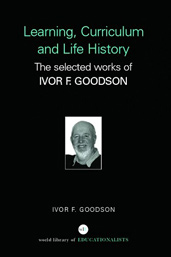Learning, Curriculum and Life Politics: the selected works of Ivor F. Goodson
Long Waves of Educational Reform
Long Waves of Educational Change
Now most commonly, our educational study focuses on individual events and reform initiatives (eventementes). Our study is concerned with short spans and snapshots because education is understandably concerned with immediate delivery of educational services in the here and now of the present. In general, our focus is short-term and action focused.
Our Spencer study was a bountiful opportunity to explore a longer view of educational change. We employed a range of data to explore change in schools from our earliest school which began in 1916 through to the millennium. Two major sources of data helped our analyses of the history of school change. Firstly we sought where possible to develop detailed historical archives of each school: school records of curriculum and timetables, school year books, journals, reports, departmental records and so on. Our initial worry was that so much of this would have been destroyed but in fact we were surprised how much had been retained: a veritable treasure trove for the reconstruction of school change. Besides this textual database, we conducted a wide range of interviews with teachers across the lifespan of each school, there were often full life history interviews. In addition we collected a range of choreographic data from school visits to meetings and lessons.
Our schools were chosen to cover a spectrum of secondary schools in our two locations in the US and Canada. The site in the US we called Bradford School district located in New York State in a medium sized industrial town. Bradford was similar to many US cities in the changes to its urban population. There had been successive waves of ‘white flight’ to the suburbs leaving the urban core mainly populated by poor families of ten minorities, particularly Afro-American. According to the district statistics in 1985, 40% of Bradford pupils lived in poverty rising five years later to nearly 70%. By 1989 of the districts pupil population 62% were African-American and 18% Hispanic. In fact it was partly as a response to these demographic shifts that the school district began creating ‘Magnet schools’ in 1980. Such magnet schools were created by the federal government in the mid-1970’s in order to encourage voluntary desegregation.
One of our chosen schools, Barrett was therefore a magnet school created in 1989 from one of the original high schools; a second school was chosen to reflect the tradition of alternative education, Durant School set up in 1971 at a time when ‘schools within walls’ were fashionable aimed to provide flexible individualized programmes for students who favoured a style of education beyond the mainstream high school programmes; our third school reflected the white flight noted earlier. Set up in the 1950’s, Sheldon had once been a showpiece comprehensive high school. But the urban catchment was transformed by the increasing poverty of the local families while the minority representation in the school sky-rocketed. These three schools were chosen to represent some of the major developments in secondary education in the Bradford District in the second half of the 20th Century.
